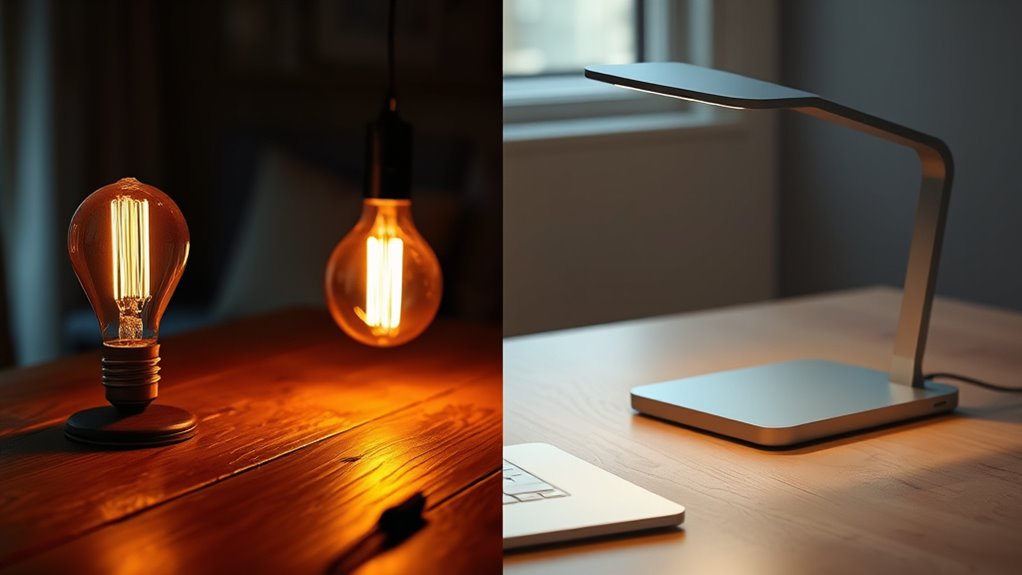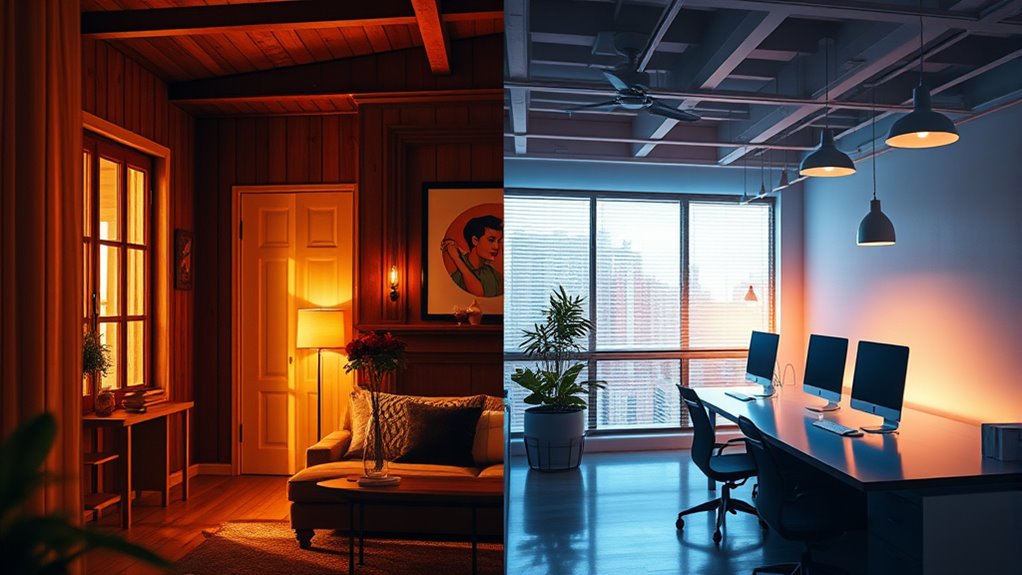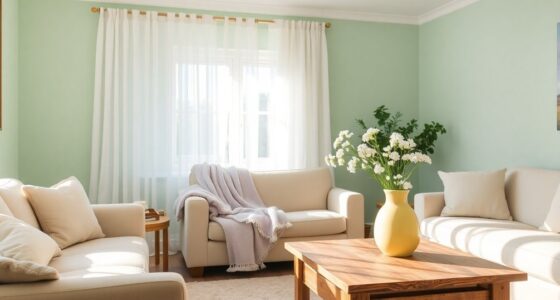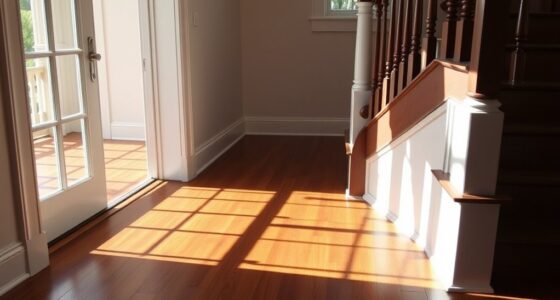Choosing between warm and cool lighting depends on the mood and function you want for your space. Warm lighting, with a color temperature around 2700K to 3000K, creates a cozy, relaxing vibe perfect for living rooms and bedrooms. Cool lighting, from 3500K to 6500K, offers bright, crisp light ideal for kitchens and work areas. Understanding these differences helps you set the right atmosphere — keep going to discover how to balance both for any space.
Key Takeaways
- Warm lighting (2700K-3000K) creates a cozy, inviting atmosphere perfect for relaxation areas.
- Cool lighting (3500K-6500K) provides bright, clear illumination ideal for work and detail-oriented spaces.
- Choose warm tones for comfort and calmness; opt for cool tones to promote alertness and productivity.
- Combining warm and cool lighting can enhance ambiance and functionality, but requires careful zone control.
- Proper color temperature selection influences mood, visual appeal, and the effectiveness of your space.

Have you ever wondered how lighting affects the mood and look of a space? The type of light you choose can dramatically influence how a room feels and appears. When it comes to lighting, understanding the difference between warm and cool tones is essential for creating the right atmosphere. Warm lighting, which has a yellowish or amber hue, tends to make spaces feel cozy, inviting, and relaxed. It’s perfect for living rooms, bedrooms, and areas where you want to promote comfort and ease. On the other hand, cool lighting, with its bluish or white tone, encourages alertness and clarity. It’s well-suited for kitchens, bathrooms, or workspaces where visibility and focus matter most.
Choosing the right color temperature depends on your goals for a space. Warm light typically falls within the 2700K to 3000K range on the Kelvin scale. It produces a soft, gentle glow that mimics the natural warmth of sunset or candlelight. This type of lighting can make a room feel more intimate and inviting. When you use warm bulbs, you’ll notice that colors appear softer and more subdued, which can be ideal for relaxing environments. Conversely, cool lighting ranges from about 3500K to 6500K. It emits a bright, crisp light that resembles daylight, helping you see details clearly and stay alert. This is particularly important in work areas or places where you need precise color rendering.
The impact of lighting isn’t just about aesthetics; it also influences your mood and productivity. Warm light can reduce stress and create a sense of calm, making it a good choice for unwinding after a long day. Cool light, however, can boost your focus and energy, making it suitable for tasks that require concentration. Think about how you want to feel in a space and select your lighting accordingly. Combining both types of lighting in a home or office can offer versatility—warm lights in cozy zones and cool lights in functional areas. Just be mindful of color temperature to avoid creating a disjointed look. Mixing warm and cool bulbs in the same room can sometimes clash, so consider using dimmers or zones to control different lighting setups.
Ultimately, getting the color temperature right enhances the way your space looks and feels. It’s about aligning your lighting choices with your desired ambiance and functionality. Whether you want a relaxing retreat or an energizing workspace, understanding the difference between warm and cool lighting helps you make smarter decisions that transform your environment into exactly what you want it to be. Additionally, paying attention to the lighting design can help you achieve a cohesive and inviting farmhouse bedroom ambiance that complements your rustic decor style.
Frequently Asked Questions
How Does Lighting Color Temperature Affect Mood and Productivity?
Lighting color temperature influences your mood and productivity profoundly. Warm lighting creates a cozy, relaxing atmosphere that helps you unwind and feel comfortable, while cool lighting boosts alertness and focus, making it ideal for work and concentration. You can enhance your environment by adjusting the lighting to match your activities, ensuring you’re energized when needed and relaxed during downtime. Proper lighting choices can improve both your mood and efficiency.
Can Warm Lighting Be Used for Outdoor Spaces?
Yes, warm lighting can be used for outdoor spaces. It creates a cozy, inviting atmosphere perfect for patios, gardens, or outdoor dining areas. Warm light highlights natural textures and enhances a relaxing vibe, making your outdoor area feel welcoming. Just make certain the fixtures are weatherproof, and consider using dimmable options to adjust brightness for different moods and occasions.
What Are the Best Color Temperatures for Reading and Studying?
For reading and studying, you should aim for a color temperature between 4000K and 5000K. This range provides bright, neutral light that reduces eye strain and keeps you alert. Avoid overly warm or cool tones, as they can cause fatigue or distraction. Use a daylight or cool white bulb, and position it to illuminate your workspace evenly. This setup helps you stay focused and comfortable during long study sessions.
How Does Aging Affect the Perception of Warm and Cool Lighting?
As you age, your eyes become less sensitive to certain colors, making warm lighting appear duller and cool lighting sometimes too harsh. You might find that warm lights are more comfortable for relaxing and reading, while cool lights help you stay alert. Adjust your lighting to match your changing eyesight, choosing warmer tones for comfort and cooler tones when you need clarity or focus.
Are There Health Risks Associated With Certain Light Temperatures?
You should know that exposure to blue-rich cool lighting can disrupt your sleep patterns, increasing your risk of health issues like insomnia or depression. Studies show that prolonged exposure to high-color-temperature lights can also strain your eyes and cause headaches. To protect your health, limit screen time in blue light-heavy environments and opt for warmer lighting in the evening. Your eyes and overall well-being will thank you.
Conclusion
Choosing between warm and cool lighting is like picking the right playlist for your mood. I once set up my living room with cool lights, feeling energized, but it turned sterile. Switching to warm tones made it cozy, like a hug. Remember, the right color temperature sets the tone—think of it as the soundtrack to your space. Get it right, and your room will feel just right, inviting you to relax or energize as you see fit.









